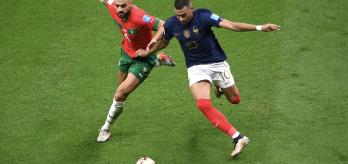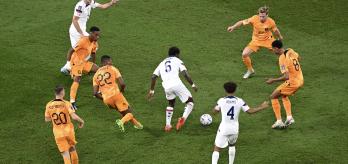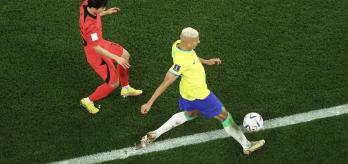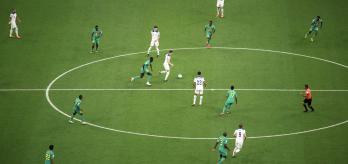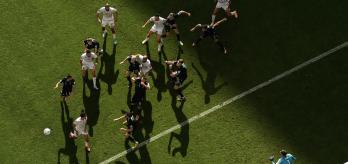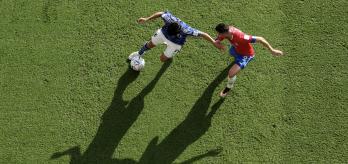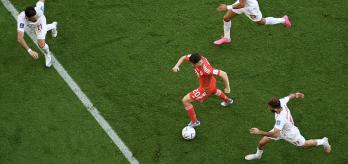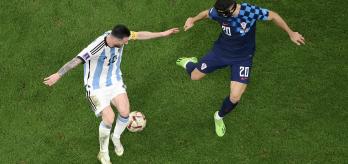Key points
-
Centre-backs and defensive midfielders cover around 70-85% of their high-intensity and sprint distances without the ball due to their specific duties (e.g. pressing, defensive recoveries and transitions).
-
Centre and wide forwards cover about 60-70% of their high-intensity and sprint distances with the ball due to their attacking roles (moving to receive the ball in space during progressions or in dangerous areas such as the final third).
-
The physical performances of selected roles with and without the ball is highly dependent on the quality and stylistic tendencies of each team.
PHYSICAL PERFORMANCE IN AND OUT OF POSSESSION FOR VARIOUS POSITIONS
It is well documented that various playing positions have unique physical demands.1,2 Although physical fitness differs between positions3, it does not fully account for the large positional differences observed in physical performances during matches. Thus, one of the main contributory factors related to position-specific match running performances is the actual positions given to players2.
Regarding roles, there is no one-size-fits-all approach as the tactical directives given to players by the coach might be specific for a style of play, formation and/or opposition. The uniqueness of each position results in large variations in the overall distance covered as well as the distances covered at higher intensities (>20km/h and >25km/h). This physical analysis has already delved into "what" distances eight different outfield positions covered but has not yet examined "how" they covered that distance.
TOTAL DISTANCE IN AND OUT OF POSSESSION FOR VARIOUS POSITIONS
We can gain a basic physical-tactical perspective regarding "how" each role performs by categorising distances covered with and without the ball. In isolation, this information simply reflects ball possession status, but by utilising FIFA's Enhanced Football Intelligence metrics alongside this information, we gain a more granular insight into "how" each position performs. Figure 1 visualises the total distance covered with and without the ball for each of the positions in the FIFA World Cup Qatar 2022™. The total distance covered by a player is composed of a high proportion of walking and jogging, which occur at lower movement speeds (Zones 1 and 2). Thus, they are not usually associated with crucial activities with and without the ball as they generally occur at higher speeds. Consequently, the higher intensities (>20km/h and >25km/h) are much more sensitive for differentiating between positions.
DISTANCES AT HIGHER INTENSITIES IN AND OUT OF POSSESSION FOR VARIOUS POSITIONS
Figures 2 and 3 clearly show that players with a vital defensive duty in the team cover a greater proportion of their distance at higher intensities without the ball. For instance, centre-backs and defensive midfielders cover around 70-85% of their high-intensity (>20km/h) and sprint distances (>25km/h) without the ball. In contrast, centre and wide forwards cover just 30-40% without the ball in the two highest speed zones. Research demonstrates that defensive players will typically cover more of their distance without the ball at higher intensities during recoveries via defensive transitions, while forwards will cover more through defending from the front via defensive pressure4. Moreover, the physical performances of selected roles without the ball will be highly dependent on the quality of the team they represent and their teams' stylistic tendencies.
Positional insights
Thus, examining teams of differing quality at the upper and lower extremes for the distance covered without the ball may add some interesting insights from a positional perspective. For instance, Saudi Arabia covered 70-115% more distance in the higher speed zones (>20km/h and >25km/h) than Argentina. Using FIFA's Enhanced Football Intelligence metrics, it becomes clear that Saudi Arabia performed around 40-160% more defensive recoveries and transitions and also made about 20-30% more direct pressure and counter-pressure actions per game than Argentina. As a result, centre-backs and defensive midfielders for Saudi Arabia covered around 15-155% more high-intensity distance without the ball (>20km/h) and performed 55-80% more direct and counter-pressure actions than their Argentinian counterparts.
Figures 2 and 3 also illustrate that players occupying an attacking role that requires them to be a direct threat to the opposition cover a greater proportion of their distance at higher intensities with the ball. For example, centre and wide forwards cover around 60-70% of their high-intensity and sprint distances (>20km/h and >25km/h) with the ball.
This high-intensity distance with the ball only makes up about 20-30% of the distance covered with the ball for centre-backs and defensive midfielders. This can be attributed to the attacking players' key roles such as moving to receive the ball in space during progressions or in dangerous areas such as the final third4. The attacking quality of a team and their unique attacking style will directly influence the activities of various positions.
The influence of a team's playing style on positions: opportunities for further study
To really emphasise this point, it would be interesting to examine two teams at the upper and lower ranges for the distance covered with the ball at higher intensities (>20km/h and >25km/h) and the associated positional trends. Costa Rica and Argentina may be poles apart in terms of team quality and style but the latter covered around 80-100% more distance with the ball at higher intensities (>20km/h & >25km/h) than the former.
Argentina performed about 70% more progressions and movements to receive and made more than twice as many final-third entries as Costa Rica. Consequently, Argentina's most attacking players, such as centre forwards, covered about 150% more high-intensity distance with the ball and performed around 160% more movements to receive the ball, particularly movements in behind and in front compared to Costa Rica's forwards. The tactical reasons for "why" players specifically exert themselves in games will be reviewed in greater detail in the case study section.
References
-
Ade JD, Drust B, Morgan O, Bradley PS. Physiological characteristics and acute fatigue associated with position-specific speed endurance soccer drills: production vs maintenance. Science and Medicine in Football. 2020, DOI: 10.1080/24733938.2020.1789202.
-
Ade J, Fitzpatrick J, Bradley PS. High-intensity efforts in elite soccer matches and associated movement patterns, technical skills and tactical actions. Information for position-specific training drills. Journal of Sports Sciences. 2016, 34: 2205-2214.
-
Bradley PS, Mohr M, Bendiksen M, Randers MB, Flindt M, Barnes C, Hood P, Gomez A, Andersen JL, Di Mascio M, Bangsbo J, Krustrup P. Sub-maximal and maximal Yo-Yo intermittent endurance test level 2: heart rate response, reproducibility and application to elite soccer. European Journal of Applied Physiology. 2011, 111: 969-978.
-
Ju W, Doran D, Hawkins R, Evans M, Laws A, Bradley PS. Contextualised high-intensity running profiles of elite football players with reference to general and specialised tactical roles. Biology of Sport. 2023, 40: 291-301.










